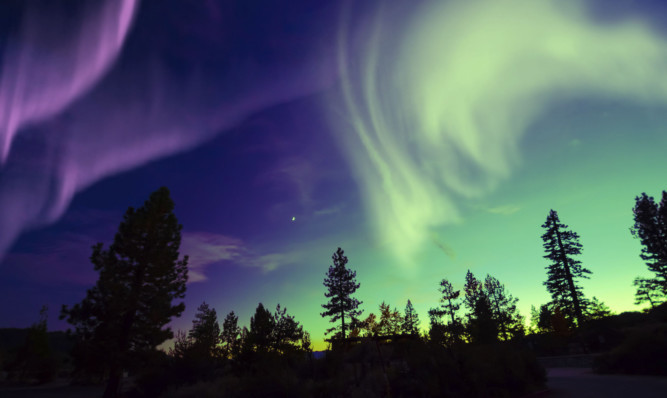Look north on a dark night and you could be treated to one of nature’s most glorious and enchanting sights. Jack McKeown discovers why this winter should give us the best chance in years of seeing the Northern Lights.
“The sight filled the northern sky; the immensity of it was scarcely conceivable. As if from Heaven itself, great curtains of delicate light hung and trembled. Pale green and rose-pink, and as transparent as the most fragile fabric, and at the bottom edge a profound fiery crimson like the fires of Hell, they swung and shimmered loosely with more grace than the most skilful dancer.” Philip Pullman ~ The Golden Compass.
Aurora borealis more commonly known as the Northern Lights have captivated mankind since prehistoric times. Most closely associated with the Arctic Circle and other areas in the far north, auroras are visible from Fife, Dundee and Perthshire only a handful of times a decade. This makes 2015 particularly special, as auroras are predicted to be more plentiful and visible further south than they have been for many years.
Someone who is keeping a closer eye on the sky than most is Dr Alex Russell.
The mathematician discovered his fascination with auroras when he was a student in St Andrews.
“I saw my first aurora on West Sands in October 2003,” he recalls. “It had been seen the previous night so a few of us went down.
“It was quite spectacular. I then met a researcher who worked on these things. That was a magical moment for me realising that I could make a living studying aurora.”
* Caf Science Extra Predicting Auroras With Dr Alex Russell is at Dundee Science Centre tonight at 6pm. The event is free and unticketed but arrive early to ensure a place
Dr Russell (29) is now a research fellow at Dundee University. Tonight he’ll be giving a free talk at Dundee Science Centre explaining why this winter gives people their best chance in years of seeing auroras in our part of the world.
“Normally they are a feature reserved for the Arctic Circle and other places with high latitudes, such as the upper reaches of Scandinavian countries,” he explains. “But the sun has cycles and right now it is at its stormiest for 11 years. When it’s stormy it puts out coronal mass ejections and if these head towards the Earth they can trigger auroras.
“Space is not a perfect vacuum. It does have particles. Coronal mass ejections can push these into the Earth’s atmosphere and cause auroras that are visible from much further south.”
But anticipating when an aurora might appear is not just a matter of keeping an eye on what the weather is like on the sun.
“The other issue about predicting aurora is the earth’s magnetic field has to be in the right position for there to be one,” Dr Russell continues. “We don’t know if this is the case until the solar flare reaches the first satellite, so we only have around an hour’s warning before the aurora happens.”
October and March are the best times for aurora, due to activity in the earth’s magnetic field around the spring and autumn.
“Aside from those times, winter is obviously better than summer because it’s much darker and you can see the skies most clearly,” Dr Russell says.
As well as being one of nature’s most glorious sights, there are other, more practical reasons why scientists want to be able to predict aurora better.
“They can actually have a very strong effect. They can knock out power grids. In 1989 they knocked out the power in Quebec. They can also cause airlines routes to be changed. That’s one of the reasons the Met Office now runs a space weather service.”
Websites such as aurorawatch.co.uk and Facebook’s Aurora Research Scotland page have led to a generation of “aurora chasers” who keep a keen eye online and are ready to race out at a moment’s notice.
“Between midnight and 2am is the best time to catch them. And if you don’t see any I doubt you’ll have wasted your time,”Dr Russell says.
“Sitting outside wrapped up cosy and looking up at the stars is a pretty fine experience even if you don’t see the Northern Lights.”
